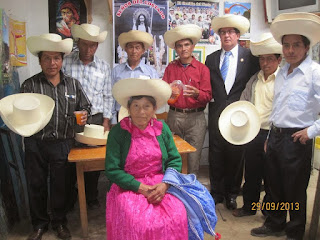The saddlebags of San Miguel, Cajamarca, crafts to take care of the
environment. Less plastic in the sea.
The seas are seriously affected by the increasing and
cumulative contamination with plastic, which, like garbage, accumulates forming
huge floating artificial islands, whose decomposition process can last hundreds
of years. Plastics, in many forms (bottles, bags, toys, tools, stands of
various products) are disposable and as they are not recycled or treated properly,
they inevitably reach the seas. Every second more than 200 kilos of plastic are
thrown into seas and oceans; 70% goes to the seabed and 15% floats. Every year
8 million tons of plastic are poured into the sea; It is estimated that by 2050
there will be, in total weight, more plastic than fish
In Peru, year 2018, due to the poor management of waste or
garbage, only 0.3% of the bags, bottles, sorbets, technopor and other plastics
collected by the municipalities are recovered; 43.7% end up in a dump, rivers
and finally in the seas. Of the 950 thousand tons of plastic purchased each
year, 74.8% becomes garbage that is collected by municipal workers. 56% of this
waste is transferred to a landfill (formal place of storage of the garbage);
Only 0.3% of the total is recycled. The remaining 43.7%, equivalent to 309
thousand tons, ends in open fields or open-air dumps, is burned or thrown into
the rivers, to end at sea.
What happens in villages far from the coast, in the highlands
and highlands of the Peruvian territory? What final destination do the various
plastic objects thrown on rural roads have? Do they only have local impact? No,
because with the rains, the winds, the plastics are dragged slowly towards the
rivers, then to the seas in an inevitable and unstoppable process.
Civic education and the formation of ecological awareness are
necessary to address the problem of pollution and minimize its effects. In San
Miguel, Cajamarca province, and in other provinces, there is an ancestral
custom of using colorful saddlebags to carry market purchases and other goods.
What is a saddlebag?
The saddlebag is the traditional woven bag with colored
threads and original designs used in the villages and rural areas of the
Cajamarca region; The saddlebag is a sample of our culture and coherence with
the slogan of caring for the environment.
The saddlebag is an inseparable part of the clothing of the
rural population; as is the portfolio of women in cities. The countrymen take
them to make purchases or daily activities, in friendly meetings to discuss the
events of the day, in family gatherings, in public events; always with his
inseparable saddlebags.
The saddlebags, versatile and colorful, are suitable for women
and men, can be carried at all times and circumstances; always present, as well
as hats, ornaments that will never be absent from the dressing room.
Would you carry a saddlebag to do your shopping?
Links to other related blogs:
San
Miguel (Cajamarca, Peru) and the charm of small towns
The
church of San Miguel (Cajamarca, Peru) - a peculiar architectural work














